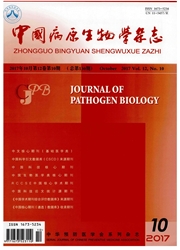

 中文摘要:
中文摘要:
目的观察旋毛虫幼虫在体外对正常小鼠肠上皮细胞(intestinal epithelial cells,IECs)的侵入及发育情况。方法将旋毛虫肌幼虫在小鼠胆汁中孵育2h,然后分别以不同密度(1.7条/cm^2、4.2条/cm^2及10.4条/cm^2)接种不同类型培养基及不同面积培养板(9.6cm^2和3.8cm^2),在37℃5%CO2条件下培养,观察幼虫存活与发育情况。结果幼虫在半固体培养基+IECs中培养36h,发育至2~4期幼虫的百分率为30.93%,而在单纯半固体培养基与DMEM完全培养基+IECs中均不能发育为2~4期幼虫(P〈0.01);半固体培养基+IECs中培养7d,低、中、高密度组虫体存活率分别为31.44%、7.82%和3.90%,差异有统计学意义(P〈0.01)。低密度幼虫在两种培养板(9.6cm^2和3.8cm^2)培养7d,发育至成虫的百分率分别为33.29%和26.19%,差异无统计学意义(P〉0.05),但仅在9.6cm^2培养皿中观察到雄虫和受孕的雌虫。结论旋毛虫肌幼虫低密度接种大面积半固体培养基+IECs培养板培养,可发育至成虫。
 英文摘要:
英文摘要:
Objective To observe the in vitro invasion of normal mouse intestinal epithelial cells (IECs) by Trichinella spiralis larvae and their development. Methods T. spiralis muscle larvae were incubated in mouse bile for 2 h and then seeded in three different types of culture media in a low (1.7 larvae/cm^2 ), medium (4.2 larvae/cm^2 ), or high (10.4 larvae/cm^2 )density and in a large (9.6 cm^2) and small (3.8 cm^2) area. The larvae were incubated at 37℃ in 5 % CO2 for 36 h, and the survival and development of the larvae in media were observed. Results When the larvae were cultured in semisolid medium+IECs, the percentage of L2-L4 larvae was 30. 93%. The larvae cultured in semisolid medium and DMEM complete medium+ IECs did not develop into L2- L4 larvae (P〉0.01). When the three densities of larvae were cultured for 7 days in semisolid medium+IECs, the low-density larvae had a survival rate of 31.44%, the medium-density larvae had a survival rate of 7.82%, and the high-density larvae had a survival rate of 3.9%. Differences in the survival rate were statistically significant (P〈0.01). When the low-density larvae were seeded in two areas (9. 6 cm^2 and 3. 8 cm^2) and cultured for 7 days, the percentage of adult worms was 33.29% and 26.19%, respectively (P〉0.05). However, only the larvae cultured in an area of 9.6 cm^2 developed into males and gravid females. Conclusion T. spiralis muscle larvae seeded in semisolid medium + IECs at a low density and in a large area were able to develop into adult worms.
 同期刊论文项目
同期刊论文项目
 同项目期刊论文
同项目期刊论文
 Normal Mouse Intestinal Epithelial Cells as a Model for the in vitro Invasion of Trichinella spirali
Normal Mouse Intestinal Epithelial Cells as a Model for the in vitro Invasion of Trichinella spirali 期刊信息
期刊信息
